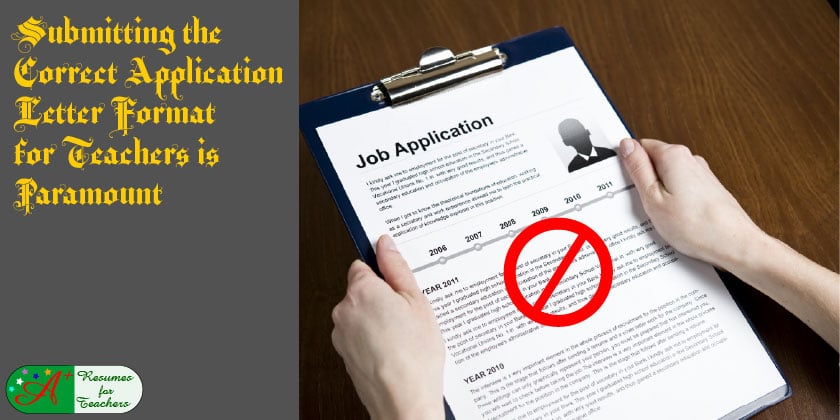One of the critical aspects of advancing your job application is using the correct application letter format for teachers or other educators. An academic application letter, also known as a cover letter or letter of introduction, introduces the reader to you.
It gives them either an excellent first impression or a mediocre or a bad one. If you do not know how to develop a proper application letter, you will surely provide the reader with a negative first impression. Result – you will likely kiss your chances of a teaching job interview goodbye!
The most appropriate application letter format for teachers is a targeted letter. You want to understand your audience, grab their attention, and appeal to their needs. Your teacher-focused cover letter lets them know what a school district will be missing if they don’t give you an academic job interview – at the very least! Before you begin writing a targeted teacher application letter, the first thing you need to do is to research the school district.
Items you should look for when researching the school include:
* Type of schools within the district (i.e., Title I, Magnate, Montessori, STEM)
* Details on the student population (i.e., inner-city, ESL, special needs, gifted)
* District/school mission statement
* Community involvement and public relations
Once you have cultivated a better understanding of the school or district you are applying to, you can format an application letter that appeals to their unique goals and needs. For instance, if you are looking for a school with a high rate of ESL students, you will want to mention any additional languages you speak, multicultural and international travel experience, language instruction skills, ability to differentiate instruction, and so forth.
On the other hand, perhaps you are applying for teaching jobs at a Title I school. Your application letter should demonstrate your ability to reach out to all types of students, work with the community, and raise funds to improve the school.
Your academic application letter should demonstrate your ability to reach out to all types of students, work with the community, and raise funds to improve the school.
Incorporating the school’s mission statement, or giving the nod to it, is a sure way to land your resume in the “to read” pile. By including or discussing the mission statement, you show the reader you understand what the school is all about and are eager to promote it. Educational administrators want to know they are hiring like-minded teachers, being a good fit, and working hard to achieve the same results.
An application letter format for teachers needs to include relevant teaching keywords.
Industry or job title keywords are another aspect to consider when integrating your application letter format for teachers. Buzzwords are popular terms, currently relevant, and looked for by hiring administrators. These keywords should be incorporated correctly into your educator application letter and resume. Some examples of academic trending words are growth mindset, digital leadership, reflective teaching, digital learning, blended learning, differentiated instruction, interactive classroom, and student-guided learning.
Initially, the letter of introduction and resume may be sent through the applicant tracking system (ATS) before a hiring authority picks them up. When they land on someone’s desk, the recipient may scan the job application documents looking for one or more of these terms; if they are omitted, you may be passed over for another teacher candidate.
Have a correctly formatted application letter ready to apply for a teaching position immediately.
Sometimes, using a targeted application letter format for teachers isn’t practical. What if you have just been aware of an excellent academic job opportunity? The only catch is the post for the teaching job closes in a few short hours. You may not have time to do the in-depth research you should. Rather than risk not getting your application in, you can submit a generic cover letter unique to your background, core competencies, and educational accomplishments. This is the only time a generic or non-targeted application letter would be better than a focused one.
This is the only time a generic or non-targeted application letter would be better than a focused one.
I don’t like the term “generic” for an academic cover letter because it shouldn’t be boring. You must write your application letter to show your passion, personality, and authenticity. Therefore, it is a good idea to have one already developed and on hand, ready to use immediately. An untargeted letter will likely be shorter than your targeted letter; it will incorporate the school district’s name, but not its unique goals and needs and probably won’t match its mission statement or motto.
When developing a top-notch teacher application letter to submit immediately, you should focus on your most outstanding talents and skills applicable to any teaching position/school district. You can review these excerpts from sample cover letters for teacher positions.
Strengths that any great teacher must possess are:
* Classroom management skills
* Capability to design creative and engaging lesson plans and activities
* Methods to use differentiated instruction to promote students’ success
* Desire and ability to teach digital literacy and promote digital citizenship
* Commitment to student learning and success
* Talent for cultivating a positive rapport with students and building their confidence
* Collaboration with students, peers, administrators, and parents.
* Capacity to effectively analyze a situation and think critically
In addition to your strengths, make sure your application letter, whether targeted or generic, highlights your academic credentials (i.e., Bachelor’s Degree, Master’s Degree), teaching certifications or licenses, relevant core competencies, and commitment to student education and the legacy you wish to create in the school community. Include your name and updated contact information (address, phone number, email, LinkedIn page) at the top of your document to match your resume.
Finally, make sure you proofread your academic application letter more than once.


